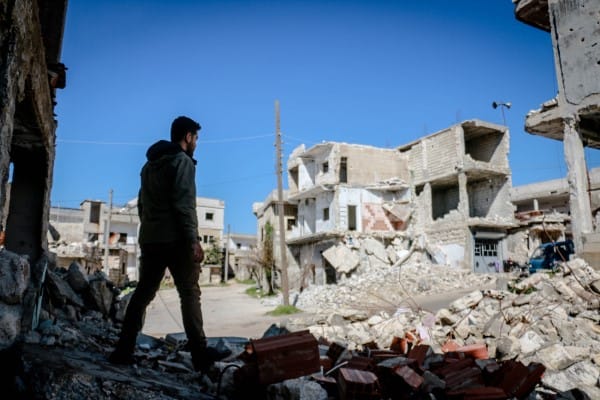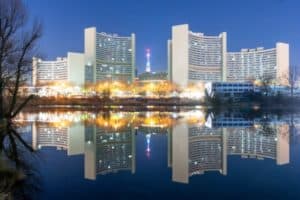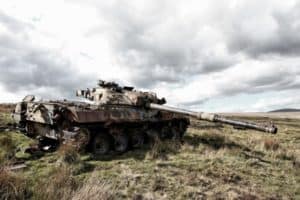Every year, billions of dollars is provided in foreign aid. Many Western countries are among the largest donors of international aid in the world. In 1970, the UN passed a resolution saying all developed countries should aim to donate 0.7% of their gross national income in overseas assistance. But what does all that money actually buy? What does foreign aid pay for?
We’ve put together a full breakdown of twelve of the most important things foreign aid budgets fund…
Humanitarian Relief
One of the most important things foreign aid pays for is humanitarian relief. When communities are hit by crises, conflicts or disasters people become in urgent need of assistance. Foreign aid helps pay for vital emergency aid.
Many poorer countries lack the resources and capabilities to assist their people when crises hit. Foreign aid plays a crucial role in paying for life saving aid. It funds emergency food, shelter, infrastructure and medical care for people affected by disasters.
Most foreign aid funds for humanitarian relief are channelled through national governments, as well as UN agencies and NGOs. Money provided by foreign aid donors allows organizations to run projects that directly assist people and communities to recover from crises. It also funds projects that build local capacities so that national actors can better respond to future emergencies.
Overseas aid funding is critical in saving lives and reducing the impact of crises on affected communities. Humanitarian relief is probably one of the most vital things foreign aid pays for.
Poverty Reduction
Today, 689 million people around the world live in extreme poverty – defined as living on less than 1.90 USD a day. Overseas aid pays for a range of projects that aim to lift people out of poverty.
Billions of dollars are spent each year in foreign aid on poverty reduction initiatives. Richer countries have a moral obligation to help people around the world who live in destitution. However, lifting people out of poverty also increases their economic power, helping to improve the development of their country. Foreign aid pays for poverty reduction because it is right, but also because assisting countries to develop increases trade and business for all countries.
As with humanitarian relief, most international aid funding for poverty reduction goes to national governments in the Global South, as well as NGOs and UN agencies. Foreign aid pays for economic, community and governmental development projects that aim to improve peoples living conditions and life chances, as well as preventing people from falling into poverty.
Children’s Education
Worldwide, 258 million children do not go to school. Overseas aid plays a major role in addressing this. One of the things foreign aid pays for is quality education for children in poor countries and young people affected by wars or disasters.
When communities are hit by crises, children’s schooling often becomes disrupted. Events like natural disasters or extreme weather damage school buildings; conflicts force children to flee to areas where education may not be available. Foreign aid funds projects that provide education to children who would otherwise go without.
As well as providing education in emergency settings, international aid also pays for schooling for children living in poverty. Foreign aid funds government projects in low and middle income countries that aim to improve access and quality of education to children and young people. It also funds schooling for children from marginalised communities so that more children can receive an education.
Improved Healthcare
Up to half the world’s population does not have access to quality healthcare. International aid helps pay to improve this situation and allow more people in low and middle income countries to access the medical assistance they need.
Many foreign aid donors fund projects that aim to improve both the access to and quality of healthcare services in developing countries. These projects are either ran though the governments Departments of Health or through NGOs and UN agencies. They fund both better equipment and drugs for medical facilities, as well as improved training for doctors and more efficient systems and processes in healthcare.
As well as paying for projects to improve healthcare outcomes for people in poorer countries, foreign aid also pays for medical care for people affected by humanitarian emergencies. These programmes aim to save lives and reduce sickness and injury for people impacted by crises, conflicts and disasters.
Clean Water and Sanitation
Clean water and good sanitation are vital for human health. Overseas aid funds projects that work to improve access to clean water for people in poorer countries, as well as improving their hygiene and sanitation.
Currently, there are 785 million people in the world who do not have access to clean water. This can be due to poverty, or the impact of natural disasters or human conflict. Foreign aids helps to pay for things like water infrastructure, pumps, wells, chlorination tablets, toilets, latrines, water trucking and water treatment facilities so that more people living in poverty can get the clean water they need.
Foreign aid also pays for the introduction of and improvements to sanitation facilities for people living in poverty, or those affected by crises.
The donation of overseas aid directly saves millions of lives each year, often of children, by funding access to clean water and improved sanitation.
Livelihood Projects
People’s livelihoods – their jobs and businesses, are vital for their prosperity. Foreign aid pays for projects that help to improve the livelihoods of people living in poorer countries, as well as provide economic opportunities for people affected by human displacement, disasters or crises.
International aid funded livelihood projects are proven ways to assist people living in poverty to help themselves. Rather than providing direct aid, livelihood projects provide materials, financial loans or short-term jobs that allow people to build businesses and gain skills that can lift themselves out of destitution.
The livelihood projects paid for by overseas aid also assist people who have lost their jobs or businesses due to humanitarian crises. These can kick-start local economies and drive the economic recovery of disaster or conflict hit areas.
Livelihood projects paid for by foreign aid are one of the best ways it can improve the lives of some of the poorest people in the world.
Military Equipment and Training
A large part of foreign aid funding goes towards providing military support to poorer countries. Helping allied countries and nations that are strategically important to the donor is a key use of foreign aid money.
Military aid is the donation or loan or funds, equipment, expertise or training to another country’s armed forces. Overseas aid pays for improvements to the military of poorer countries so that they may better defend themselves from external aggression and achieve internal security.
Donor nations such as the US, UK, France, Russia and China provide billions of dollars a year in military aid to their allies. A large part of the money provided pays for equipment and services from the donor country, which in-turn gives them an economic boost.
Overseas aid also pays for the development of new military technologies, as well as collaborations between the armed forces of donor countries and their strategic allies.
Emergency Food and Nutrition
Famine and hunger are still major problems in many parts of the world. One in three people globally face some degree of malnutrition and about 30 million people are living in famine conditions.
International aid funds vital food assistance to people affected by famines. This aid saves lives and helps to limit the long-term health complications that can occur from malnutrition. Foreign aid pays for emergency food assistance for people as well as critical nutrition for mothers and babies.
As well as providing food aid to people affected by famine, international aid pays for improved agriculture and farming methods in developing countries. This aims to makes crops more resilient to droughts and other weather events to reduce the incidents of famine.
Millions of dollars a years are provided in emergency food and nutrition through foreign aid programmes. This money is funnelled through national governments, and NGOs such as Oxfam, Action Against Hunger as well as UN agencies such as the World Food Programme.
Shelter For Displaced People
There are currently 26.4 million refugees in the world. In addition, millions of people have been displaced within their own country. There are also millions of people who migrate to escape poverty.
One vital thing that overseas aid pays for is shelter for displaced people. Refugees and IDPs can be forced to flee their homes because of war, persecution or human rights abuses. People also migrate due to lack of opportunities or because natural disasters have destroyed their homes and livelihoods. Foreign aid funds much needed shelter for people forced to move.
As well as paying for the establishment and running of refugee and displaced person camps, foreign aid pays for projects to reconstruct damaged housing following conflicts or disasters. Having adequate shelter is critical to survival and international aid funds shelter for millions of people who might otherwise go without.
Protection For Vulnerable People
When communities are hit by crises, the networks that often protect more vulnerable members of society are broken. Foreign aid funds projects that help to protect more vulnerable people during crises.
Although all people are vulnerable when crises affect their communities, certain groups – such as women, children, the elderly, and sexual and ethnic minorities, become especially vulnerable. International aid pays for projects that help protect these people from exploitation, abuse and harm. It also funds projects that aim to re-establish community ties and rebuild the networks that often protect these groups.
Protecting especially vulnerable people during a crisis is one of the most important things foreign aid pays for. Without this funding, instances of abuse, neglect, exploitation, harm and even death to people from vulnerable groups would be significantly increased. Foreign aid funds UN agencies and NGOs to run a wide range of protection projects.
Disaster Recovery
A crucial area that international aid provides funding to is disaster recovery. When countries are hit by disasters that overwhelm their own capacities to respond, they call on the international community for assistance. Foreign aid pays for a wide range of life saving disaster recovery projects.
Disasters such as earthquakes, tsunamis, floods, cyclones and typhoons can cause huge destruction, especially in developing countries where infrastructure is less able to withstand their impact. Overseas aid funds the deployment of rescue teams, as well as specialized equipment, to help rescue people following a disaster.
As well as rescue missions, foreign aid also funds rebuilding and recovery for communities affected by disasters. These projects assist communities to rebuild their lives and livelihoods and return to a degree of normality after a disaster.
Other important areas that foreign aid funds are disaster preparedness and disaster risk reduction. There help limit the impact of future emergencies on vulnerable communities.
Peace Building Initiatives
Finally, foreign aid pays for a range of peace building projects that aim to end armed conflicts and stabilise peace in areas recently ravaged by war.
Most armed conflicts require outside support to bring warring factions together and negotiate an end to the fighting. Conflicts also tear societies and communities apart and create rifts that must be addressed in order for peace to last. Overseas aid funds many initiatives that work on ending conflicts and addressing the issues communities have faced that caused the fighting. It also pays for assistance to communities affected by the aftermath of armed violence.
Foreign aid funded peace building initiatives include government and NGO projects that aim to bring peace to conflict zones and prevent a return to violence. International aid also funds UN peacekeepers that monitor fragile peace agreements and protect civilians.
Peace building and peace keeping are perhaps some of the most important things foreign aid pays for.





